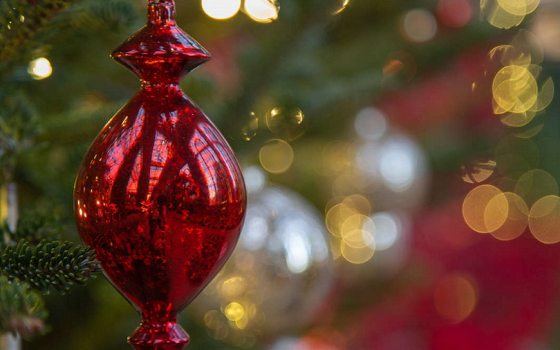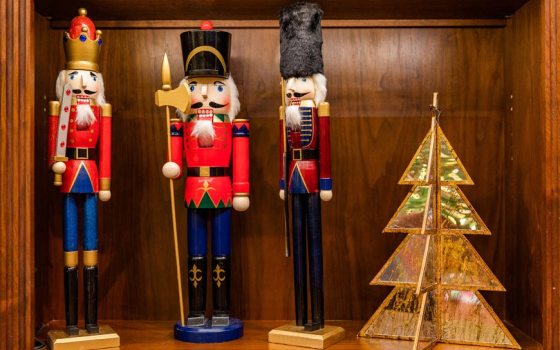Decorating a tree is not only a cherished holiday tradition, but a practice that is rooted in design and one meant to evoke a feeling of warmth and cheer. As a senior horticulturist here at Longwood, I’ve led the design of the Music Room for nearly a decade now, and our Music Room tree is a huge (huge in the literal and figurative sense) element of the Music Room design. I always go into designing the Music Room with a story in my head, and this year I envisioned the most beautiful sitting room that calls us all back to the visions of the holidays as a child. That vision was achieved, in large part, with how we decorated the Music Room tree, using specific design principles that you too can apply when decorating your own tree.
At Longwood the first thing we think about when it comes to a Christmas tree is how big of a tree we need for a certain space. Our spaces are very large and having done A Longwood Christmas for so many years (we first opened our Christmas celebration to the public in 1957), we know what size trees we need for each space. For instance, in the East Conservatory the main tree is always around 25 feet tall. In the Music Room we always have an 18-foot-tall Fraser fir, as they are very open by nature and show off their ornaments instead of hiding them. Also, their branches are nice and strong to hold all of those ornaments! In the home, a good rule of thumb is that the tree and topper should measure about 5 to 6 inches from the ceiling.
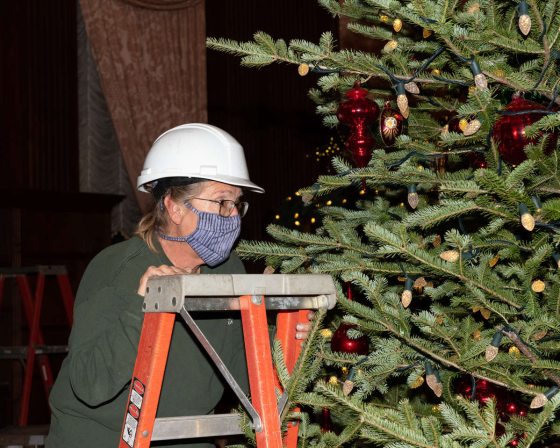
Our next consideration is that year’s display theme. This year the theme happens to be more traditional. The theme is what usually leads us to pick the colors and styles of the ornaments we want to use. Last year in the Music Room we had a candy theme and the candy cases were all a light blue, so I based my ornament colors on the colors of Jordan almonds and clear glass. All pastel and opalescent. This year we are going with traditional red, green, and gold and we looked for ornaments that had a traditional 1950s and 60s look to them. But what if you wanted to do a beach themed tree? You might pick the colors of the sea and sand, drawing on ornaments from the sea and more pearlescent finishes, like the inside of a shell. I think that whatever colors you choose, you always need a touch of metal to add shine and sparkle. Gold, silver, and copper go with any colors.

When it’s time to start decorating the tree, we start by lighting it. We use LED lights exclusively for a variety of reasons. These save energy, they don’t get hot and dry out your tree, and they are now available in a wide variety of colors and styles. I personally like white lights. I think they allow you to see the colors of the ornaments clearer whereas multi-colored lights tend to bleed the color out of some ornaments. I do, however, like to light a tree completely in white lights and run a few strings of a colored light throughout the tree which we did in our 2019 Music Room display. The trees were lit in white but we ran a few strings of a light blue light throughout them. The blue lights then became almost another ornament. This year, we’re using warm white LED lights that have a pinecone cover to diffuse the brightness. We used about 40 strings of light this year, or about 2,000 individual lights, for our Music Room tree. At home, the standard formula is 100 lights for each 1.5 feet of tree. Of course, if you like more lights, go for it!
The next element that goes on the tree is the garland. Garlands can be made of anything you like. I’ve made them with magnolia leaves and pinecones, Paulownia pods, manzanita branches, and simple ribbon. In 2019 we used opalescent cellophane which literally gave the whole tree a shimmer. Our trees are so big that we generally make our garlands in 4- to 6-foot sections and make them look like one long garland by how we install them in the tree. For this year’s Music Room tree, we’re using a 150-foot-long garland of round red balls all wired together. Generally, it’s a good idea to figure on 9 feet of garland for every 1 foot of tree. This is tricky though … if your garland is very thick you may not need that much, or if you’re using just a set of beads, you may need more.
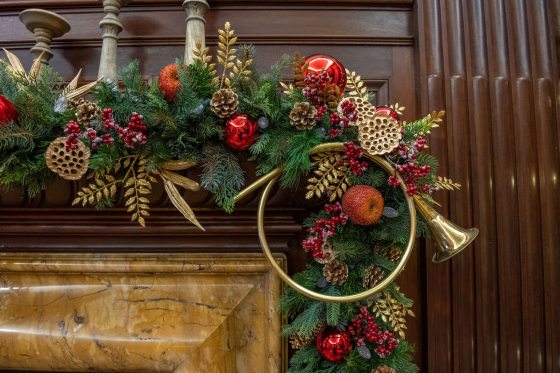
Next for me is usually the tree topper. I like to have a bit of fun with the tree toppers. One year we had a tree in the Music Room with a “garland” we had made of full-sized musical instruments. I made the tree topper out of three clarinets. Last year our tree toppers were a collection of giant lollipops made out of foam! The one thing you have to look for is that the tree topper is in scale with the height of the tree. A very wide tree calls for a chunkier tree topper, while a slim tree could use a traditional vintage topper of between 6 and 9 inches for a 6- to 7-foot tree. For our 18-foot-tall trees, I generally try for a topper that is 18 to 24 inches tall. You also cannot make it so heavy that it wants to bend the top of the tree.

Next comes the ornaments. We have a pretty specific routine here at Longwood. The largest ornaments go on first. These tend to hang more inside the tree. They fill up any larger holes and add shine and movement all the way to the inside of the tree. We add each style of ornament from largest to smallest, layer after layer. Doing it this way helps us get even coverage of all the ornaments. This year, we started with our 8-inch red balls and 9-inch finials.
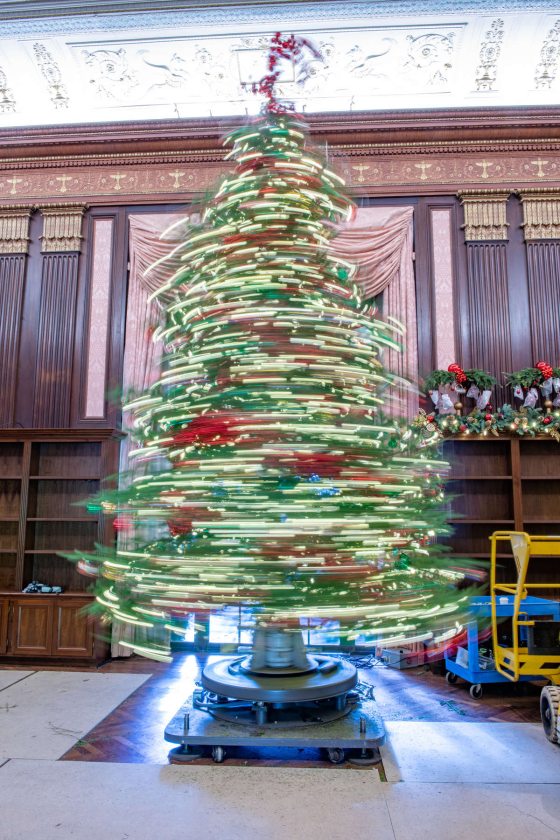
This is an important time to always be taking a step back from the tree to be sure that you’re getting the look that you want. The number of ornaments is really up to you. Sometimes I want a tree to be packed with ornaments, but sometimes I want less ornaments if I want to feature some other part of the tree’s decorations. For instance, for our Music Room tree with the musical instrument garland, I wanted less ornamentation so the garland was the real star of that show. This year, we’re really packing the ornaments on the Music Room tree … about 800 in total! Why so many ornaments? My own nostalgia, I think. My mother always loaded our trees with ornaments … and that is my own tradition. This year, I really love the old-fashioned red and green ornaments we used on the Music Room tree.
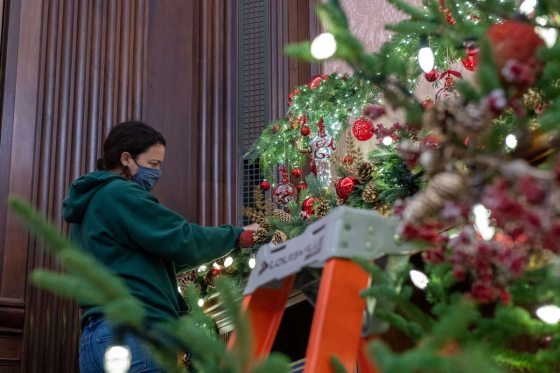
Lastly comes what we call the tippers. For us it’s usually an icicle of some kind, but you could also use tiny millimeter balls or tinsel. This year, we’re using a very thin clear icicle that reminds me a little of the old-fashioned silver tinsel … but it’s much easier to clean up!
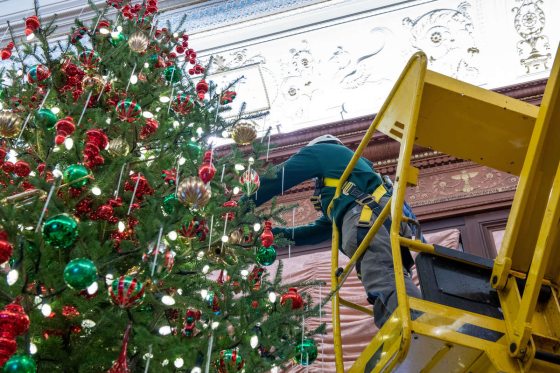
I think a tree is not properly dressed until you’ve covered up the tree stand. Here at Longwood we have a fantastic carpentry shop and they have built some beautiful tree boxes to hide some of our mechanics, with designs ranging from a music box to one made out of books! This year, we’re using a walnut box the shop had previously crafted to match the walnut paneling in the Music Room. At home, a few yards of velvet wrapped around the stand can be just as pretty.
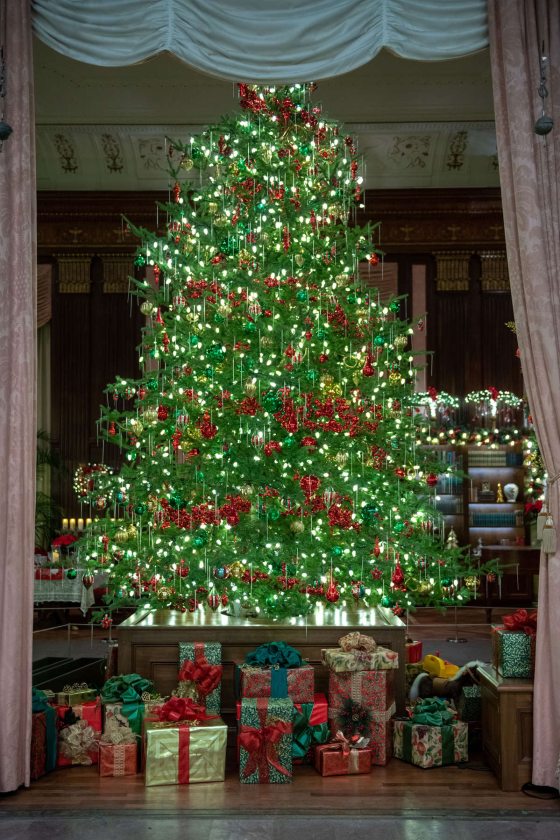
Come see the Music Room tree in all its decorated glory (and much more!) during A Longwood Christmas, on view through January 10.
